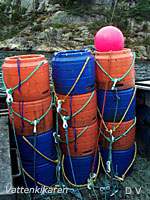
|
|
Sensitive to overfishing
By continually fishing the same area, it
is possible to estimate the population size and how fast a population recovers
after fishing has ceased. In this way, populations have been estimated to
be about 30kg per hectare in the Kattegatt. A year after overfishing had
ceased, the population had not recovered. The common whelk is very sensitive
to exploatation, probably because sexual maturity occurs late and
that they produce relatively few offspring and that spreading is poor.
Furthermore, they often congregate in groups and are easily caught.
Protecting the common whelk
Fishing for whelks can only be regulated
by controlling the number of pots and the period when they can be fished.
A method to ensure that new individuals are produced is to regulate their
minimum size when caught and sold, but it is unfortunately difficult to
establish a minimum size as sexual maturity can vary greatly between neighbouring
areas. If adherence to regulations is to be easier, they should be common
for several countries. A prerequisite for whelk fishing to be long term
is to guarantee that all whelks reach sexual maturity. Unfortunately, fishing
in this way is not economically viable and therefore several countries have
a lower minimum size.

Fishing can be regulated by controlling the number of
pots.
|

|
Page 14
of 15
|

|
|